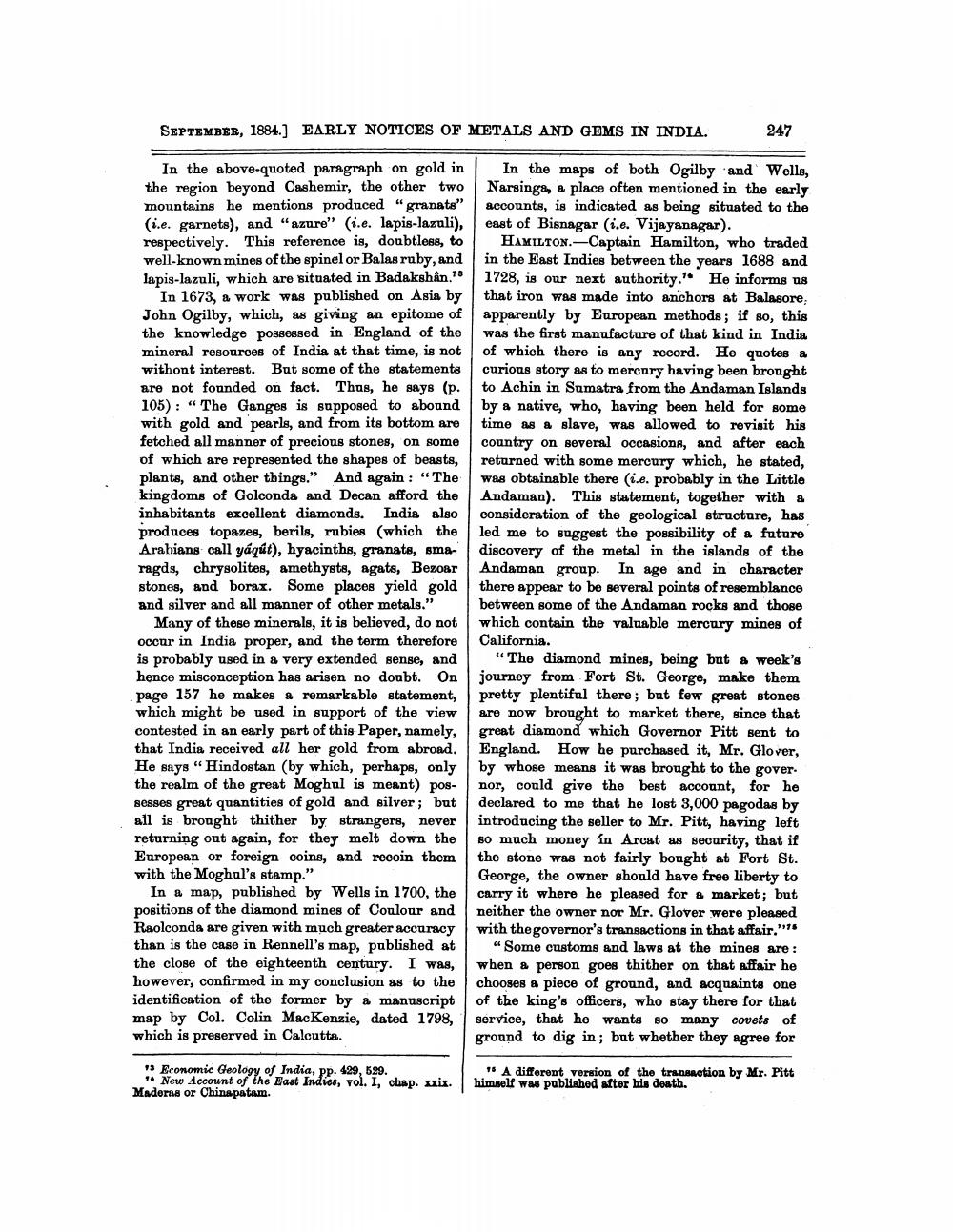________________
SEPTEMBER, 1884.] EARLY NOTICES OF METALS AND GEMS IN INDIA.
247
In the above-quoted paragraph on gold in the region beyond Cashemir, the other two mountains he mentions produced "granats" (i.e. garnets), and "azure" (i.e. lapis-lazuli), respectively. This reference is, doubtless, to well-known mines of the spinel or Balas ruby, and lapis-lazuli, which are situated in Badakshân."
In 1673, a work was published on Asia by John Ogilby, which, as giving an epitome of the knowledge possessed in England of the mineral resources of India at that time, is not withont interest. But some of the statements are not founded on fact. Thus, he says (p. 105): "The Ganges is supposed to abound with gold and pearls, and from its bottom are fetched all manner of precious stones, on some of which are represented the shapes of beasts, plants, and other things." And again : "The kingdoms of Golconda and Decan afford the inhabitants excellent diamonds. India also produces topazes, berils, rubies (which the Arabians call yáqút), hyacinths, granate, omaragds, chrysolites, amethysts, agats, Bezoar stones, and borax. Some places yield gold and silver and all manner of other metals."
Many of these minerals, it is believed, do not occur in India proper, and the term therefore is probably used in a very extended sense, and hence misconception has arisen no doubt. On page 157 he makes a remarkable statement, which might be used in support of the view contested in an early part of this Paper, namely, that India received all her gold from abroad. He says "Hindostan (by which, perhaps, only the realm of the great Moghul is meant) possesses great quantities of gold and silver ; but all is brought thither by strangers, never returning out again, for they melt down the European or foreign coins, and recoin them with the Moghul's stamp."
In a map, published by Wells in 1700, the positions of the diamond mines of Coulour and Raolconds are given with much greater accuracy than is the case in Rennell's map, published at the close of the eighteenth century. I was, however, confirmed in my conclusion as to the identification of the former by a manuscript map by Col. Colin MacKenzie, dated 1798, which is preserved in Calcutta.
In the maps of both Ogilby and Wells, Narsinga, a place often mentioned in the early | accounts, is indicated as being situated to the east of Bisnagar (i.e. Vijayanagar).
HAMILTON.-Captain Hamilton, who traded in the East Indies between the years 1688 and 1728, is our next authority." He informs as that iron was made into anchors at Balasore, apparently by European methods; if so, this was the first manufacture of that kind in India of which there is any record. He quotes a curious story as to mercury having been brought to Achin in Sumatra from the Andaman Islands by a native, who, having been held for some time as a slave, was allowed to revisit his country on several occasions, and after each returned with some mercury which, he stated, was obtainable there (i.e. probably in the Little Andaman). This statement, together with a consideration of the geological structure, has led me to suggest the possibility of a future discovery of the metal in the islands of the Andaman group. In age and in character there appear to be several points of resemblance between some of the Andaman rocks and those which contain the valuable mercury mines of California.
"The diamond mines, being but a week's journey from Fort St. George, make them pretty plentiful there; but few great stones are now brought to market there, since that great diamond which Governor Pitt sent to England. How he purchased it, Mr. Glover, by whose means it was brought to the gover. nor, could give the best account, for he declared to me that he lost 3,000 pagodas by introducing the seller to Mr. Pitt, having left 80 much money in Arcat as security, that if the stone was not fairly bought at Fort St. George, the owner should have free liberty to carry it where he pleased for a market; but neither the owner nor Mr. Glover were pleased with the governor's transactions in that affair.''
"Some customs and laws at the mines are : when a person goes thither on that affair he chooses a piece of ground, and acquaints one of the king's officers, who stay there for that service, that he wants so many covets of ground to dig in; but whether they agree for
" Economic Geology of India, pp. 429, 529.
New Account of the East Indies, vol. I, chap. xxix. Maderas or Chinapatam.
" A different version of the transaction by Mr. Pitt himself was published after his death.




